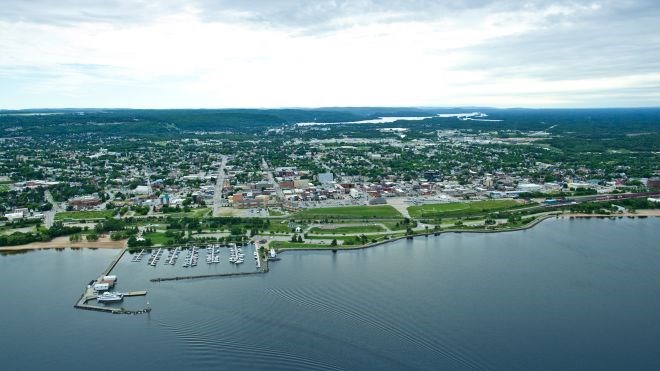After months of consultation, North Bay’s Downtown Waterfront Master Plan will be ready for public viewing this February, and the city expects council approval by spring.
The 10-month consultation and design phase got underway last year under the direction of Brook McIlroy, which held a series of consultation sessions through the summer and fall.
A final design, said Bev Hillier, the city’s manager of planning services, will bring a more cohesive look to the waterfront, creating a stronger link between it and the nearby downtown.
“We have a great downtown, and so this was an opportunity to look at the downtown, and not just the waterfront, and to see how the two spaces can really connect together,” she said.
“There’s been some work on the former rail lands piece around the museum, and there’s been some work done specifically on the waterfront, but the idea of this was about tying all of that together and thinking about how everything connects and where we want to go for that next 20 years.”
Past work on the rail lands, which the city acquired from Canadian Pacific in 1999, includes the addition of a biking trail, a walkway, two carousels, a kids’ train, and the museum, which was formerly the CP train station. The city also built an underpass so pedestrians could access the waterfront from the downtown.
A comprehensive consultation process took place involving stakeholders, members of the public, through online surveys, and with Indigenous partners, and so the final plan will be a true reflection of what the public wants to see on the waterfront, she added.
Last fall, the city presented three draft schematics, all with different layouts, dubbed Oak Park, Central Park, and The Pier. Each of the plans differs slightly, but all share some common elements: a splash pad/skating rink, more seating and trees throughout the area, and a mix of public and private sector investment.
The plan’s overall goal is to enhance existing elements to create a sense of place that can be enjoyed year-round, Hillier said.
Private development in the area is already well underway. It includes a $20-million, 100-unit Homewood Suites hotel featuring a Starbucks coffee shop and a restaurant. The North Bay Parry Sound District Health Unit is constructing a two-storey headquarters with 59,000 square feet of space. And Marina Point Retirement Residence is spending $24 million on a major expansion that will add 113 units to its complex.
After some additional consultation through January, the design firm will determine the best location for each of the components and compile that into one final design, which will then go to council for approval.
“Sometimes it’s about finding the right location for certain things to occur,” Hillier said.
Because this plan lays out a 20-year vision for the downtown and waterfront, Hillier said individual projects would be rolled out in phases, into projects that can be completed over the immediate, short, medium and longer terms.
Immediate-term projects are items that can be done within six to 18 months, short term project could be rolled out in five years, medium-term projects would be done in five to 10 years, and long-term plans would be implemented in 10 or more years.
Some of the simpler projects could be things like amending the city’s own bylaws to allow for things like renting space to ensure city policy is aligned with the plan’s vision, Hillier said.
The timing on some of the projects may shift depending on funding opportunities and what’s going on in the community at the time, Hillier added.
Tendering and applications for funding will be done for each individual project, Hillier said, and because the plan hasn’t yet been approved, no municipal funding has yet been set aside.
The exception is the reconstruction of downtown main street, something that’s been in the budget for several years, Hillier said.
“You only spend that amount of money to redo it once every 25 years or so, and so if we're at that stage, this was an opportunity to make sure that we're doing it the right way, rather than just redoing the same thing over and over,” she said.
Hillier emphasized that a successful rollout of the plan is contingent on community support and collaboration with public and private sector partners.
“This isn't something the city can just get done itself,” she said. “It's something that the community can champion and that the private sector and our different community stakeholders can really work towards achieving parts of as well. So we hope that this is a plan and a vision that's a larger community buy-in to see it really be successful.”




